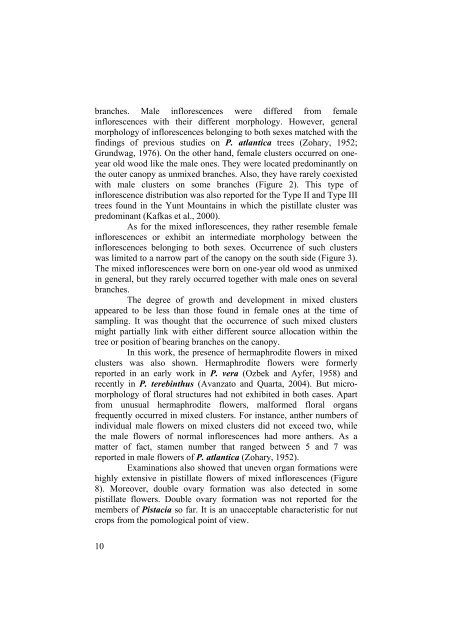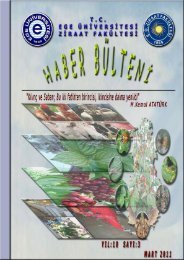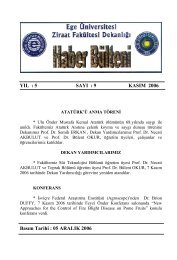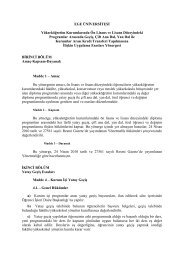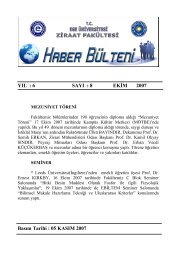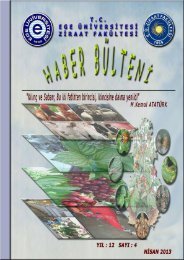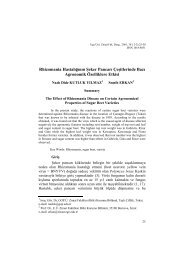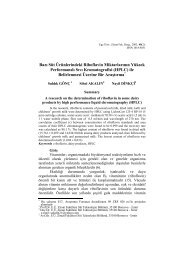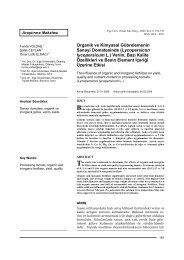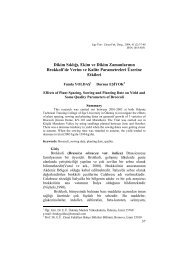Hermaphroditism in Pistacia atlantica Desf. : A New Report from ...
Hermaphroditism in Pistacia atlantica Desf. : A New Report from ...
Hermaphroditism in Pistacia atlantica Desf. : A New Report from ...
You also want an ePaper? Increase the reach of your titles
YUMPU automatically turns print PDFs into web optimized ePapers that Google loves.
anches. Male <strong>in</strong>florescences were differed <strong>from</strong> female<br />
<strong>in</strong>florescences with their different morphology. However, general<br />
morphology of <strong>in</strong>florescences belong<strong>in</strong>g to both sexes matched with the<br />
f<strong>in</strong>d<strong>in</strong>gs of previous studies on P. <strong>atlantica</strong> trees (Zohary, 1952;<br />
Grundwag, 1976). On the other hand, female clusters occurred on oneyear<br />
old wood like the male ones. They were located predom<strong>in</strong>antly on<br />
the outer canopy as unmixed branches. Also, they have rarely coexisted<br />
with male clusters on some branches (Figure 2). This type of<br />
<strong>in</strong>florescence distribution was also reported for the Type II and Type III<br />
trees found <strong>in</strong> the Yunt Mounta<strong>in</strong>s <strong>in</strong> which the pistillate cluster was<br />
predom<strong>in</strong>ant (Kafkas et al., 2000).<br />
As for the mixed <strong>in</strong>florescences, they rather resemble female<br />
<strong>in</strong>florescences or exhibit an <strong>in</strong>termediate morphology between the<br />
<strong>in</strong>florescences belong<strong>in</strong>g to both sexes. Occurrence of such clusters<br />
was limited to a narrow part of the canopy on the south side (Figure 3).<br />
The mixed <strong>in</strong>florescences were born on one-year old wood as unmixed<br />
<strong>in</strong> general, but they rarely occurred together with male ones on several<br />
branches.<br />
The degree of growth and development <strong>in</strong> mixed clusters<br />
appeared to be less than those found <strong>in</strong> female ones at the time of<br />
sampl<strong>in</strong>g. It was thought that the occurrence of such mixed clusters<br />
might partially l<strong>in</strong>k with either different source allocation with<strong>in</strong> the<br />
tree or position of bear<strong>in</strong>g branches on the canopy.<br />
In this work, the presence of hermaphrodite flowers <strong>in</strong> mixed<br />
clusters was also shown. Hermaphrodite flowers were formerly<br />
reported <strong>in</strong> an early work <strong>in</strong> P. vera (Ozbek and Ayfer, 1958) and<br />
recently <strong>in</strong> P. tereb<strong>in</strong>thus (Avanzato and Quarta, 2004). But micromorphology<br />
of floral structures had not exhibited <strong>in</strong> both cases. Apart<br />
<strong>from</strong> unusual hermaphrodite flowers, malformed floral organs<br />
frequently occurred <strong>in</strong> mixed clusters. For <strong>in</strong>stance, anther numbers of<br />
<strong>in</strong>dividual male flowers on mixed clusters did not exceed two, while<br />
the male flowers of normal <strong>in</strong>florescences had more anthers. As a<br />
matter of fact, stamen number that ranged between 5 and 7 was<br />
reported <strong>in</strong> male flowers of P. <strong>atlantica</strong> (Zohary, 1952).<br />
Exam<strong>in</strong>ations also showed that uneven organ formations were<br />
highly extensive <strong>in</strong> pistillate flowers of mixed <strong>in</strong>florescences (Figure<br />
8). Moreover, double ovary formation was also detected <strong>in</strong> some<br />
pistillate flowers. Double ovary formation was not reported for the<br />
members of <strong>Pistacia</strong> so far. It is an unacceptable characteristic for nut<br />
crops <strong>from</strong> the pomological po<strong>in</strong>t of view.<br />
10


